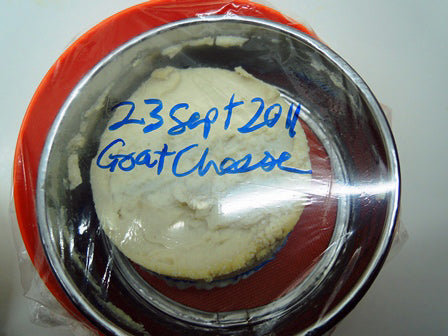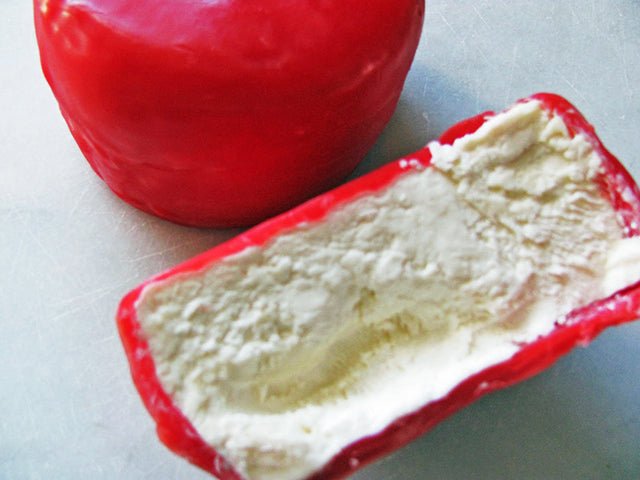 |
| An example of healthy looking Blue Cheese |
It’s about CONTROLLING the bacteria!
 |
| Dr. Peter Achutha |
We recently received an interesting note from Dr. Peter Achutha, our longtime friend in Malaysia. He’s been a guest blogger twice – A Malaysian Scientist Experiments with Making Cheese and Durian Cheesecake for the Intrepid Only!.
Peter is a scientist who likes to experiment with food, so at his website, The Bread Diaries, you will find articles like his 4 part series – making cream cheese from yogurt, numerous posts about making bread, including his piece de resistance – making bread from self-rising flour, and his scariest experiment to date – how to make dead cow cheese which involves fermenting milk with yeast. (He charms us in the middle of that one by linking to our site when he says, “If you are serious about learning how to make cheese, here is the link.”
When we received Peter’s letter, I was concerned that he might be going a bit too far afield with his cheese experiments. I felt obliged to forward it to our technical advisor, Jim Wallace. (A brief note about Jim- He has been teaching advanced workshops and answering all technical questions for us for many years. He has literally seen and heard everything having to do with cheese. However, even Jim was a bit dismayed by Peter’s adventures, as you will see in the correspondence below.)
I hope everyone (especially Peter) will be able to benefit from Jim’s advice, so that everyone (especially Peter) can live to a ripe old age, making and eating their own healthy homemade cheese.
1. Note from Peter Achutha
Remember the last time I wrote to you both about my utter failure at making cheese? Well, I decided to try one last fling at it … like it was some quite flirtatious affair. It was do or die. If ‘do’ then it would probably mean more misery with my affair with cheese. If ‘die’ then gone for good, good riddance and the end to a cheesy chapter of my life.
The thing about my kitchen or rather my fridge was that, over the last year it had become a bio-hazard laboratory. I had quite a few Tupperwares of cheese in various stages of maturity … actually I am trying to be polite as they were at various stages of rot.
Worst still, my bio-hazard material had quietly invaded my mom’s fridge and I had some “secret recipes” there. At least that’s what I told her. No wonder my mom would complain that her fridge was too small and that there was not enough space in her fridge.
So, after I wrote to both of you I decided to clear out the fridge(s). I had a peak in some of the Tupperwares and some of them looked like swivel and others looked like nothing had happened.
It truly is amazing how life evolves … when it chooses to. Then I found this container of goats ‘cheese.’ It was one of those milk to yogurt to cheese experiments. It almost looked like cheese but it tasted of yogurt. It had shrunk a lot since it was a thick batter when I placed it on a sieve to mature slowly. The sieve was to allow the water to drain out slowly so that it would solidify with time. Actually it was sitting in the back of my fridge for a year when I remembered it was there.
I threw it away as I had used rice paper at the bottom to support the ‘liquid’ cheese and the rice paper had something growing underneath. The goat’s cheese was OK and it tasted more like a rock of yogurt than cheese.
That was the last of the bio-hazard material.
I had to try one last fling so I bought some cream cheese, Tarantula cream cheese – Australian. Took out the Penicillium roqueforti that had been in deep hibernation in my freezer for, I think, 2 years. I was not really expecting it to work.
I put a flat teaspoon of Penicillium roqueforti into a jar filled with two liters of water and let them revive over night. I sprinkled a tablespoon of the water (there was a bluish layer at the bottom of the jar which I did not use) on the cheese and poked holes with a fork to get the oxygen into the cream cheese … and waited. Nothing happened. Then I remembered that you could not stand there and watch it grow. So I put it back in the fridge – my mom’s fridge and forgot about it for a week.
A week later, I noticed two pin head size tiny, tiny specks of blue and green. The cheese chapter of my life was closing quickly. I left it back in the fridge and thought nothing of it for a few weeks.
About a month later I notice that the whole top layer of cream cheese was layered in blue green stuff. There were white patches, so I assumed that the white patches were areas where the mold had not taken root. I took some pictures and when examining the pictures noticed that the white areas were white mold – the whole top of the cheese was covered in blue green mold and white mold!
So now I have a problem. Do I eat the stuff or not? If I eat it and it is delicious, the cheese chapter will have a lot more written in it. If I eat the stuff and turn blue green, then my cheese chapter will end, the book will be closed and all my blogging will come to an end. You know what they say – ‘”ashes to ashes and dust to dust.”
Does it look like blue cheese? Please do let me know. Maybe I should try cheddar this way. What would you call this? Cheat cheese? Anything more exotic?
Ps: I woke up this morning and found my head was still on my neck, whew….
2. Jim Wallace’s answer
Peter, what you have there is definitely a good growth of the blue mold and most likely the one you added (but one never knows for sure).
Now the problem here is that the blue mold is meant to grow internally but in order to do that the cheese needs to be made with a bit firmer curd so that when the cheese is put together there are small openings internally. The blue needs fresh air to grow.
The cheese you have chosen to use is too moist and too dense. It also is a bit too acidic for the mold to grow internally. The cheese you used is essentially a Greek (drained) style yogurt and not one that will do well with a blue mold.
What you need for blue is a curd set with rennet and then allowed to form a good firm curd before molding. This is often done by dry stirring the curds as you drain them before going into the mold.
The blue mold you have on the outside might not taste great in such large amounts. It is actually not the blue mold that adds the flavor but how the blue produces enzymes that change the flavor of the curds.
3. Peter’s response to Jim
Actually, I know I am not anywhere near good at making cheese. You guys have achieved perfection, cheese nirvana and cheese enlightenment. I, on the other hand, feel like a ‘bum in a china shop’ on the way to cheese imperfection and cheese ‘delightenment.’
I learned a lot from Jim’s e-mail and have cut up the cheese to expose more of it to air and allow the blue mold to spread. I tried the stuff that stuck to the knife and it was simply gorgeous, simply delicious. So now I plan to get some other molds like cheddar and infect some cream cheese with it – probably April time frame.
I am really excited by the blue cheat cheese and planning more experiments with the blue mold – probably with other drier types of cheeses. Or, mix different ‘off the shelf’ cheeses and infect them with blue mold. hhhmmmmm … I have to find another excuse to tell my mom.
4. Jim tries again
Peter, I caution you on these experiments without the knowledge of what is growing.
2 big problems would be:
1. In not producing enough acid, thus leaving lactose for unhealthy bacteria to grow on. The biggest culprit would be botulism or butyric bacteria as well as coliforms such as E.Coli.
2. If you do not create the proper surface conditions for a target healthy ripening mold, you may develop some unwanted growth such as the Listeria producers.
There are many other things that can be unhealthy and deadly even.
Cheese making is really about controlled decomposition of milk where the proteins and fats are broken down to specific components for flavor and texture but all in a healthy way.
Just leaving the cheese to whatever happens to come along is looking for something bad to pop up.
I am not trying to discourage you here but safe processing is VERY IMPORTANT. People do get sick or even die from cheese processed or stored improperly.






















































































































































